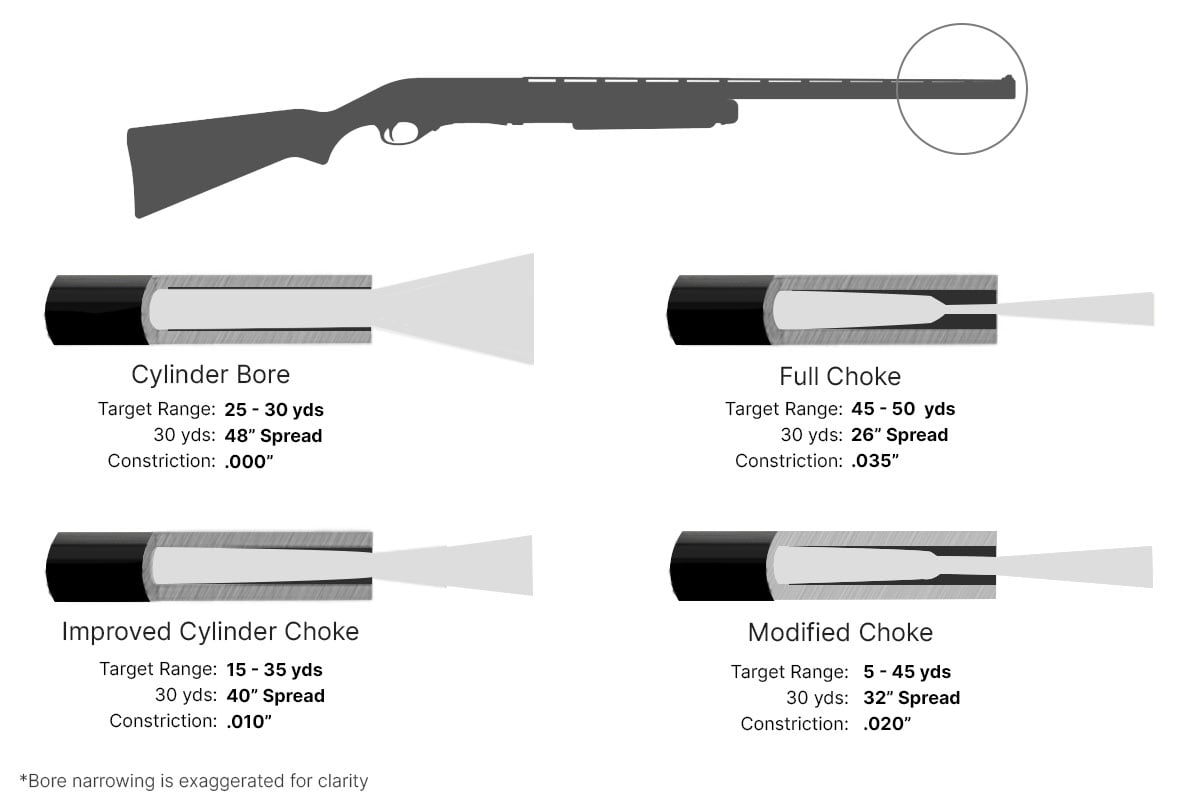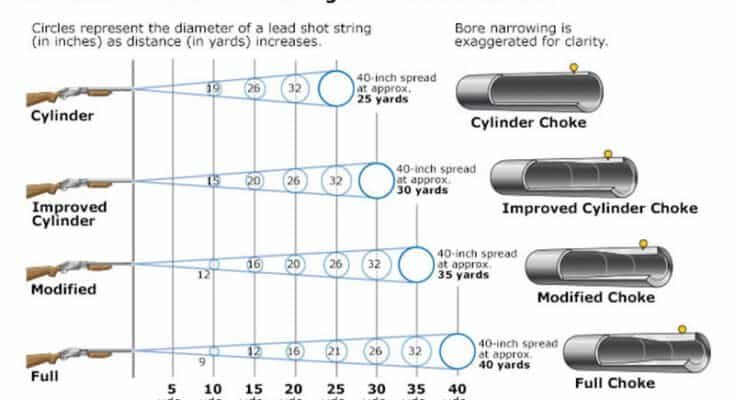Are you passionate about improving your shooting game? Whether you’re a seasoned hunter or a shooting sports enthusiast, understanding your equipment can make all the difference.
One crucial aspect of shotguns that often raises questions is the choke. Specifically, you might be wondering, “Which shotgun choke is the tightest? ” This question is more than just about equipment; it’s about enhancing your precision, boosting your confidence, and ultimately achieving better results.
Dive into this guide, and discover how the right choke could be your game-changer. You’ll learn not only which choke is the tightest but also how it can elevate your shooting experience. Ready to hit your target with pinpoint accuracy? Let’s explore the world of shotgun chokes together.

Shotgun Choke Basics
Understanding shotgun choke basics can dramatically improve your shooting skills and accuracy. A shotgun choke is a simple device attached to the end of your shotgun barrel. It controls how the shot spreads once it leaves the barrel. Whether you’re hunting, shooting skeet, or defending your home, knowing the right choke can make a big difference.
Purpose Of A Choke
A choke plays a crucial role in determining the spread pattern of the shot. Think of it as your tool for precision. By tightening the spread, it allows you to hit targets more effectively. A tighter pattern means more pellets hit your target, increasing your chances of a successful shot. Have you ever missed a target because of a wide spread? A choke might be your answer.
Types Of Shotgun Chokes
There are several types of shotgun chokes, each serving unique purposes. The most common ones include:
- Full Choke:This offers the tightest constriction. Ideal for long-range shooting, it’s perfect for hunting game like turkey. If you enjoy challenging shots, this might be your go-to.
- Modified Choke:Slightly looser than a full choke, it’s versatile for medium ranges. Great for upland bird hunting, where distances can vary.
- Improved Cylinder Choke:Provides a wider spread, making it suitable for close-range shooting. Useful for home defense or shooting clay targets.
- Cylinder Choke:This has no constriction, offering the widest pattern. It’s commonly used in law enforcement for crowd control.
Have you experimented with different chokes? Changing them based on your shooting activity can yield surprising results. You might find your accuracy improving by simply swapping chokes. It’s worth a try.
Choosing the right choke depends on your specific needs and shooting conditions. What will you be aiming at next? Whether it’s a challenging hunt or a friendly competition, the right choke can be your secret weapon.

Measuring Choke Tightness
Understanding shotgun choke tightness is crucial for hunting and shooting enthusiasts. Chokes influence the spread of pellets fired from a shotgun. Knowing how to measure choke tightness helps in choosing the right one. This section provides insights into how choke tightness impacts shooting performance.
Constriction Levels
Shotgun choke tightness is determined by constriction levels. A choke constricts the barrel’s end to shape the shot pattern. There are different levels of constriction, such as cylinder, improved cylinder, modified, and full. Full choke offers the tightest constriction. It narrows the barrel significantly, resulting in a compact shot pattern. This type is ideal for long-range shooting, giving precision and accuracy.
Impact On Shot Pattern
Choke tightness directly affects the shot pattern. A tighter choke produces a narrower shot spread. This makes it effective for hitting distant targets. On the other hand, a more open choke results in a wider spread. It’s suitable for close-range targets, increasing the chance of hitting moving objects. Different choke types cater to varying shooting needs. Understanding their impact on the shot pattern enhances hunting and shooting experiences.
Tightest Choke Options
Choosing the right shotgun choke is crucial for hunting or sport shooting. The tightest choke options offer precision and control. Understanding these options helps maximize performance and accuracy. Let’s delve into the specifics of each type.
Full Choke Characteristics
Full chokes are popular for long-range shooting. They provide a dense pattern by constricting the barrel end. This creates a focused shot, ideal for small targets. Hunters use full chokes for birds like pheasants and ducks. The constriction measures about .030 inches, ensuring a tight spread. Full chokes work best with lead shot.
Extra Full And Turkey Chokes
Extra full chokes offer even tighter constriction. These chokes have a .040 inches restriction. They are designed for very tight shot patterns. Turkey chokes are a type of extra full choke. They maximize shot density for hunting turkeys. This choke ensures all pellets hit the target. Precision is key when using extra full chokes.

Choosing The Right Choke
Choosing the right shotgun choke can greatly impact your hunting success. A choke controls the spread of pellets from your shotgun. This affects how you hit your target. Different chokes suit different needs. Understanding these differences helps in selecting the best one for your hunt.
Considerations For Game Types
Game type influences choke choice. For smaller birds, a tighter choke works best. It helps in focusing the shot at longer distances. For larger game, a more open choke is ideal. It provides a wider spread to hit bigger targets effectively. Knowing your target helps in selecting the perfect choke.
Environmental Factors
Environmental conditions also affect choke selection. In open fields, a tighter choke performs better. It ensures longer range and accuracy. In dense woods, an open choke is more suitable. It allows for a wider spread, increasing chances of hitting your target. Weather plays a role too. Windy conditions may require adjustments in choke tightness.
Expert Recommendations
Many experts suggest the full choke as the tightest option for shotguns. It focuses the shot pattern, making it ideal for long-range targets. This choke provides a concentrated spread, enhancing precision in hunting and shooting sports.
When selecting the tightest shotgun choke, expert recommendations can provide valuable insights. Whether you’re a seasoned hunter or a beginner, understanding which chokes perform best in various situations can enhance your shooting experience. Different experts bring their own unique perspectives, ensuring you have a well-rounded view of the options available.Insights From Seasoned Hunters
Seasoned hunters often have a treasure trove of insights gathered from years in the field. Many recommend using a full choke for situations where precision is key, such as turkey hunting. A full choke provides a tighter shot pattern, which can make all the difference when you’re aiming at a target from a long distance. Some hunters have shared stories of using a modified choke when hunting ducks or upland birds. This choke offers a balance between spread and accuracy, making it a versatile choice for varying ranges. Have you ever missed a shot because your pattern was too wide or too tight? Experimenting with chokes based on these recommendations might just improve your success rate.Advice From Shooting Instructors
Shooting instructors often emphasize the importance of matching your choke with your intended purpose. They suggest starting with a cylinder choke for beginners who are learning to hit moving targets. This choke has the widest spread, allowing for more forgiveness as you hone your skills. Instructors also advise that more experienced shooters consider an improved cylinder choke for skeet shooting. This choke offers a slightly tighter pattern than the cylinder, which can help you challenge yourself as you improve. Have you thought about how your choke choice affects your accuracy and confidence? Whether you’re learning from hunters or instructors, these insights can help you make informed decisions about your shotgun choke. Each recommendation adds a layer of understanding, allowing you to tailor your choice to your specific needs and preferences.Maintenance And Care
Keeping your shotgun choke in top condition is essential for achieving optimal performance. Proper maintenance and care not only ensure the tightest shot patterns but also extend the life of your equipment. Whether you’re a seasoned shooter or just starting out, knowing how to maintain your chokes can make a significant difference in your shooting accuracy and overall experience.
Proper Cleaning Techniques
Cleaning your shotgun choke is crucial for maintaining its effectiveness. A dirty choke can cause erratic shot patterns, making it difficult to hit your target. Start by removing the choke from the barrel. Ensure you have the right tools, like a choke tube wrench and a soft brush. Use a solvent that breaks down residue without damaging the metal. After applying the solvent, gently scrub the choke tube with your brush.
Don’t forget to clean the threads, as dirt can accumulate there, affecting the fit. Rinse the choke thoroughly with warm water and dry it completely. Remember, moisture can lead to rust, which can compromise your choke’s integrity. A thin layer of gun oil can help prevent rust and keep the choke functioning smoothly.
Longevity Tips For Chokes
Chokes can last a long time if cared for properly. Store them in a dry place to prevent moisture build-up. Consider using a protective case for your chokes when traveling. This reduces the risk of damage and keeps them clean. Regular inspections are also key. Look for signs of wear or rust and address them promptly.
Rotate your chokes to ensure even wear. This is especially important if you frequently use one specific choke. Regular use of different chokes can prevent any single choke from wearing out prematurely. Ask yourself, how often do you check your chokes? A small time investment in their care can lead to significant improvements in performance.
Do you have your own choke care routine? Share your experiences and tips. Your insights could help others improve their shooting game. Taking care of your chokes ensures they stay tight and reliable, enhancing your shooting experience each time you pull the trigger.
Frequently Asked Questions
What Is The Tightest Shotgun Choke?
The tightest shotgun choke is typically the full choke. It constricts the shot pattern significantly, offering a dense spread. This makes it ideal for long-range shooting. Full chokes are commonly used for hunting waterfowl or turkeys, where precision and range are crucial for success.
How Does Choke Affect Shot Pattern?
Choke affects the shot pattern by controlling the spread of pellets. A tighter choke like a full or modified concentrates the pattern for long distances. Conversely, an open choke like cylinder or improved cylinder allows a wider spread, suitable for close-range targets.
Why Choose A Full Choke For Hunting?
A full choke provides a concentrated shot pattern, ideal for long-distance hunting. It increases the likelihood of hitting small or distant targets, such as waterfowl or turkeys. Precision and range are enhanced, making it a preferred choice for hunters seeking accuracy over long distances.
Can You Use A Full Choke For Trap Shooting?
Yes, a full choke can be used for trap shooting. It offers a tight shot pattern, which is beneficial for hitting targets at a distance. Many trap shooters prefer it for its accuracy and consistency, especially in competitive scenarios where precision is crucial.
Conclusion
Choosing the right shotgun choke matters. It affects your shooting accuracy. The tightest choke is the full choke. It delivers a concentrated shot pattern. Ideal for long-range shooting. Use it for hunting or clay shooting. Remember, each situation needs the correct choke.
Practice helps you understand your shotgun better. Adapt your choice based on conditions. This makes you a better shooter. Experiment with different chokes for best results. Safety is important. Always follow proper handling and shooting guidelines. Enjoy your shooting experience responsibly.



